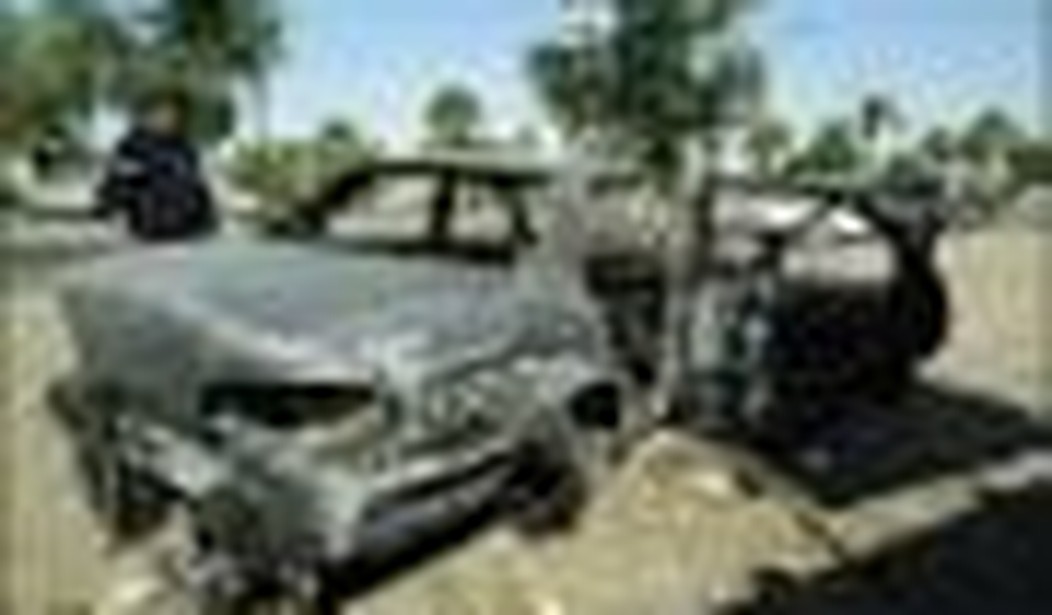On September 17, 2007, a Blackwater Worldwide (now Xe and pronounced “zee”) personal security detail escorting a U.S. State Department diplomatic team in a convoy opened fire in Baghdad’s crowded Nisoor Square, reportedly killing 17 Iraqi civilians without provocation.
Most witnesses agree on how the shooting started, when a car being slowly driven down the wrong side of the road refused to yield for Iraqi policemen and continued to drive towards the State Department convoy. Blackwater guards, fearing a potential vehicle-borne improvised explosive device (VBIED), fired warning shots, and when the driver of the vehicle failed to stop, they opened fire on the vehicle, killing both the driver and passenger.
From this point accounts from various witnesses and in some of the various investigations begin to diverge.
Some versions have claimed that the Blackwater guards — and one in particular — began to fire wildly into the crowded square after the car’s occupants were killed, though the convoy was not taking any incoming fire during any part of the firefight. Other versions, such as that released in the aftermath of the shooting by the State Department’s own Diplomatic Security Service, reported that the team was caught in an ambush involving 8-10 attackers wearing civilian clothes and Iraqi police uniforms. The DSS account reports that the convoy’s Bearcat Tactical Armored Vehicle was disabled during the ambush and had to be towed from the scene. Other accounts combine variations of the two examples above or insert fire from helicopters, Iraqi police, and muzzle flashes from inside buildings and vehicles around the square as part of a chaotic scene.
The firefight in Nisoor Square quickly bloomed into a full-scale diplomatic row between coalition military forces, the Iraqi government, and the State Department. Blackwater was temporarily blacklisted by the Iraqi government and eventually was pushed out of Iraq. The State Department is still trying to find replacement security contractors as Blackwater’s contract expires in May.
Five of the Blackwater guards in the Nisoor Square shooting face manslaughter charges brought by the U.S. Justice Department in December 2008 in what some critics call a purely political prosecution made to assuage the anger of Iraqi government officials.
Now some curious findings from FBI evidence labs suggest there may be something more to the story:
Five Blackwater guards face manslaughter and weapons charges for their role in the shooting, which left 17 Iraqis dead and inflamed anti-U.S. sentiment abroad. Prosecutors say the contractors launched an unprovoked attack on civilians using machine guns and grenade launchers. The guards maintain their convoy was ambushed by insurgents.
The FBI lab reports, obtained by the Associated Press from someone not involved in the criminal case, allow for both possibilities.
Investigators recovered .30-caliber bullets from a survivor, a Blackwater truck, and around Baghdad’s Nisoor Square. Scientists could not determine whether those bullets came from .30-caliber Blackwater machine guns.
The AK-47 rifles favored by many Iraqi insurgents also fire .30-caliber bullets.
The claim above — that scientists could not determine whether the bullets came from Blackwater’s guns — is curious, if not outright dubious.
It suggests that FBI scientists did not have access to all of Blackwater’s firearms thought to have been used in the firefight and/or that bullets and bullet fragments they recovered were too damaged to establish a ballistic match to the guns that fired them.
It also suggests that scientists could not test the metal composition of the bullets and fragments recovered against remaining bullets from those lots of ammunition known to have been imported by Blackwater to see if they were a chemical match, which I would have thought would have been one of the first alternatives the lab would have tried if an exact ballistic match could not have been established.
This is all stated with the assumption that some of Blackwater’s guards used firearms chambered for the exact same 7.62x39mm cartridge favored by the insurgency.
If Blackwater’s guards in Nisoor Square were instead armed with 7.62×51 NATO weapons and not those chambered for 7.62×39, then it should have been very easy to determine what kind of gun fired the .30-caliber bullets in question based upon bullet weight and design alone.
The 7.62×39 “30 Russian” round is most commonly manufactured for military use with a 122- or 123-grain bullet. The 7.62×51 NATO (.308 Winchester) is typically fitted with 150-grain bullets for typical use or heavier match loadings for precision marksman and sniping applications.
Frankly, the information provided by the FBI in this Associated Press account seems lacking.
If this is all that the FBI would release, that is not the news agency’s fault, but it would seem apparent that the FBI scientists have many questions they should answer regarding the kinds of tests that even a layperson such as myself readily understands as the kinds of tests that should have been run to rule the found bullets as either coming from Blackwater’s known weapons and weapon types or coming from insurgents or even Iraqi police forces some accounts allege were part of an ambush of the State Department convoy.
While it would not necessarily justify the excessive use of force alleged, if the tests that the FBI should have run could confirm that the bullets recovered had the chemical composition of lots of ammunition known to have been provided to Iraqi forces, and that Iraqi government forces were responsible for at least some of the civilians shot and property destroyed or the damage that disabled the Blackwater armored vehicle in the attack, such a finding would potentially be very damaging politically to a Justice Department case tailor-made for an Iraqi government that has long tried to portray Blackwater Worldwide as unprovoked aggressors.
Blackwater’s security forces will complete their final missions in May of this year, having never lost a diplomat in their charge in Iraq to enemy fire.









Join the conversation as a VIP Member